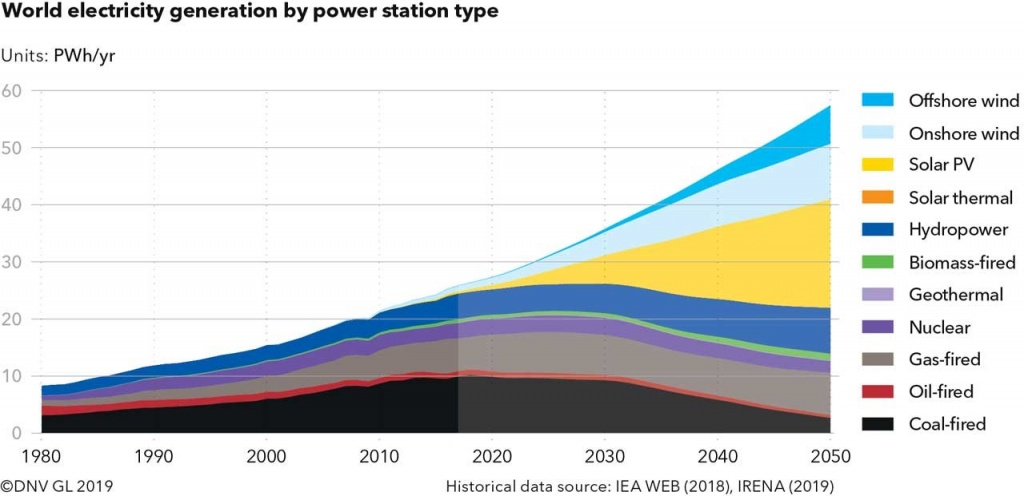TOP 6 directions of world shipping and shipbuilding development. Where should Ukraine go?
1. Offshore wind energy
Today, one of the most serious environmental problems is climate change, and the wind, as a renewable clean source of energy, is a significant part of solving. Excessive wind energy can be safely collected and generated in many parts of our planet. It does not produce hazardous waste and by-products. Wind energy solves energy security issues and significantly meets the growing demand. The life cycle of modern turbines is at least 20 years, and the efficiency is up to 85%. Wind power is one of the cheapest of all forms of renewable energy, which makes it possible to make a real breakthrough in reducing the cost of its production.
For the past two years the use of wind energy has increased significantly. Experts predict a 30% increase in wind energy use by 2050. The leaders in this direction at the moment are Europe and North America. However, there is an active development of the “offshore wind” technology in new regions where this technology has not been used or has been used a little (including in Ukraine).
Wind energy is growing by 30% by 2050

It seems that wind turbines should be located at sea. The wind blows harder and it is constant. Here it would be possible to arrange the largest turbines. Most offshore wind farms are being built in Europe due to the dense population, limited space and large offshore zones with a shallow seabed.
However, the problem of climate change demands the use of the land part for the construction of coastal power plants. For example, in the United States there are large coastal zones suitable for generating wind power. And there are not so many of them in the sea.
Wind turbines are installed away from shipping lines in order to avoid interference with ship traffic. If the ship is off its course, radars will recognize the turbines. The turbines themselves have warning devices.

2. Digitalization in marine industry
The digital revolution is transforming the world. Data is generated, used, stored and analyzed in quantities and at a rate that grows exponentially from year to year. Today, the data that we create, access and control has an increasing impact on both our lives and industry performance. In the field of shipping, digitalization and data use have had a huge impact.
Vessels began to be equipped with sophisticated sensory equipment that is capable of generating, concentrating and analyzing data and transmitting them in real time from anywhere in the world. At the same time, satellite communications developments improve connections, which can significantly increase the amount of transmitted data at lower cost. All this undoubtedly has a positive impact on safety, environmental performance.
Combining data streams from multiple sources allows the marine industry to make more informed decisions faster. New technologies such as Big Data platforms are beginning to have a significant impact on management of information, as well as on designing and testing of components of ships.
3. Ship size, renewable energy and digitalization: what are container ships expecting in the nearest future?
Today the container shipbuilding segment is facing completely new technological challenges: transporting more goods with less energy consumption and, ultimately, reducing carbon emissions into the environment. And the efforts of the world's shipbuilders will be concentrated on their solution.
The following upcoming digital changes are highlighted at international events:
1. automatic collection of data about the cargo location and about the environment (for goods requiring special conditions of transportation and storage);
2. automatic analyzer of information about loading / unloading;
3. a platform that allows to analyze and search for the best rates for transportation, including multimodal transportation;
4. blockchain platforms to ensure transparency of entire transportation process.
4. Alternative fuels and technologies. New Alternative Fuel Insight Platform.
This platform provides extensive data to create the cost for alternative fuels for vessels. Why should we use alternative fuels?
The shipping industry is under tremendous pressure in accordance with the Paris agreement on the greenhouse gas emissions regulation and it is forced to look for new, more environmentally friendly kinds of fuel. Expert expect for significant emission reductions over the next decades which course stimulation of technology development and, in particular, the introduction of low-carbon fuels.
Among all alternative kinds of fuel DNV GL identified SPG, LNG, biofuels, and hydrogen as the most promising for shipping.
DNV GL also considers wind power to be potential for use on ships.
Based on this analysis, over the next fifty years, shipping companies will be forced to invest in refitting vessels.

5. Autonomous and remotely controlled ships
The European Union aims to increase the competitiveness of coastal shipping in comparison with railway and road transport. In this regard, unmanned autonomous vessels are seen as the future of the shipping industry. This idea is supported by ambitious equipment manufacturers service providers who intend to invest in this industry. The positive point is that this creates a new market, but consumers have a whole series of questions.
There are assumptions that outfitting vessels with remote control equipment for will lead to an increase in cost (even taking into account the liquidation of crew rooms). We will need coastal infrastructure with monitoring and control systems. Maintenance of such vessels and repairs will be more expensive. (Many types of repair work are now carried out by the crew with a relatively low salary).
These costs can hardly be compensated by lower costs for crewing. Therefore, shipowners have no special economic interest in switching to autonomous vessels.
However, Maersk is ready to consider switching to autonomous vessels by 2030–2035. This period coincides with the end of the period of use of part of their vessels. But shipowners said that autonomous shipping would only be considered with commercial justification and a number of competitive advantages by eliminating the cost of crewing services.
6. Forecasts of the value of shipping assets for 2050.
In 2050, greenhouse gas emissions from shipping will be reduced by at least 50%. The shipping industry is expected to act in accordance with the Paris Agreement and reduce greenhouse gas (GHG) emissions. The goal is to reduce total GHG emissions from shipping by at least 50% in 2050 and reduce average carbon emissions (CO2) by 40% in 2030 and by 70% in 2050 compared to 2008. All this entails significant changes in the application of technologies in shipbuilding and in energy supply, and, as a result, will affect the value of shipping assets. Reducing carbon emissions and cleaning ballast water will increase energy use in shipping. Ballast water treatment, distillates, scrubbers, catalysts and exhaust gas circulation are all measures that increase energy demand. This will require the use of technologies and solutions that are not yet sufficiently developed, and the use of large volumes of environmentally friendly fuel with zero carbon content. A significant reduction in emissions will increase the cost of transportation. And the most important factor will be to reduce the cost to an acceptable one.
Important strategies for the shipping industry (to adapt to switching to alternative energy):
- in the deep-water segment, dual-fuel and alternative “ready-made” solutions can smooth this transition, laying the foundation for future modernization;
- tanks, on-board systems and offshore fuel infrastructure can give the industry more opportunities as new fuels and technologies become available.
The forecast shows that the consumption of low-carbon and carbon-neutral fuel is important to achieve the IMO GHG goals, since carbon-neutral fuel should provide 30–40% of the total energy of the world fleet by 2050. The model predicts that various kind of fuel will come to the first place. In all directions, liquefied methane (both from fossil and non-fossil sources) provides a significant portion (40–80%) of fuel in 2050. The forecast also suggests that in the deep-water segment, ammonia, biodiesel, liquid biogas and electric fuel promise a neutral level of carbon emissions, while solutions for hybrid and hydrogen systems are potential options for ships making short transportation.
Today, one of the most serious environmental problems is climate change, and the wind, as a renewable clean source of energy, is a significant part of solving. Excessive wind energy can be safely collected and generated in many parts of our planet. It does not produce hazardous waste and by-products. Wind energy solves energy security issues and significantly meets the growing demand. The life cycle of modern turbines is at least 20 years, and the efficiency is up to 85%. Wind power is one of the cheapest of all forms of renewable energy, which makes it possible to make a real breakthrough in reducing the cost of its production.
For the past two years the use of wind energy has increased significantly. Experts predict a 30% increase in wind energy use by 2050. The leaders in this direction at the moment are Europe and North America. However, there is an active development of the “offshore wind” technology in new regions where this technology has not been used or has been used a little (including in Ukraine).
Wind energy is growing by 30% by 2050

It seems that wind turbines should be located at sea. The wind blows harder and it is constant. Here it would be possible to arrange the largest turbines. Most offshore wind farms are being built in Europe due to the dense population, limited space and large offshore zones with a shallow seabed.
However, the problem of climate change demands the use of the land part for the construction of coastal power plants. For example, in the United States there are large coastal zones suitable for generating wind power. And there are not so many of them in the sea.
Wind turbines are installed away from shipping lines in order to avoid interference with ship traffic. If the ship is off its course, radars will recognize the turbines. The turbines themselves have warning devices.

2. Digitalization in marine industry
The digital revolution is transforming the world. Data is generated, used, stored and analyzed in quantities and at a rate that grows exponentially from year to year. Today, the data that we create, access and control has an increasing impact on both our lives and industry performance. In the field of shipping, digitalization and data use have had a huge impact.
Vessels began to be equipped with sophisticated sensory equipment that is capable of generating, concentrating and analyzing data and transmitting them in real time from anywhere in the world. At the same time, satellite communications developments improve connections, which can significantly increase the amount of transmitted data at lower cost. All this undoubtedly has a positive impact on safety, environmental performance.
Combining data streams from multiple sources allows the marine industry to make more informed decisions faster. New technologies such as Big Data platforms are beginning to have a significant impact on management of information, as well as on designing and testing of components of ships.
3. Ship size, renewable energy and digitalization: what are container ships expecting in the nearest future?
Today the container shipbuilding segment is facing completely new technological challenges: transporting more goods with less energy consumption and, ultimately, reducing carbon emissions into the environment. And the efforts of the world's shipbuilders will be concentrated on their solution.
The following upcoming digital changes are highlighted at international events:
1. automatic collection of data about the cargo location and about the environment (for goods requiring special conditions of transportation and storage);
2. automatic analyzer of information about loading / unloading;
3. a platform that allows to analyze and search for the best rates for transportation, including multimodal transportation;
4. blockchain platforms to ensure transparency of entire transportation process.
4. Alternative fuels and technologies. New Alternative Fuel Insight Platform.
This platform provides extensive data to create the cost for alternative fuels for vessels. Why should we use alternative fuels?
The shipping industry is under tremendous pressure in accordance with the Paris agreement on the greenhouse gas emissions regulation and it is forced to look for new, more environmentally friendly kinds of fuel. Expert expect for significant emission reductions over the next decades which course stimulation of technology development and, in particular, the introduction of low-carbon fuels.
Among all alternative kinds of fuel DNV GL identified SPG, LNG, biofuels, and hydrogen as the most promising for shipping.
DNV GL also considers wind power to be potential for use on ships.
Based on this analysis, over the next fifty years, shipping companies will be forced to invest in refitting vessels.

5. Autonomous and remotely controlled ships
The European Union aims to increase the competitiveness of coastal shipping in comparison with railway and road transport. In this regard, unmanned autonomous vessels are seen as the future of the shipping industry. This idea is supported by ambitious equipment manufacturers service providers who intend to invest in this industry. The positive point is that this creates a new market, but consumers have a whole series of questions.
There are assumptions that outfitting vessels with remote control equipment for will lead to an increase in cost (even taking into account the liquidation of crew rooms). We will need coastal infrastructure with monitoring and control systems. Maintenance of such vessels and repairs will be more expensive. (Many types of repair work are now carried out by the crew with a relatively low salary).
These costs can hardly be compensated by lower costs for crewing. Therefore, shipowners have no special economic interest in switching to autonomous vessels.
However, Maersk is ready to consider switching to autonomous vessels by 2030–2035. This period coincides with the end of the period of use of part of their vessels. But shipowners said that autonomous shipping would only be considered with commercial justification and a number of competitive advantages by eliminating the cost of crewing services.
6. Forecasts of the value of shipping assets for 2050.
In 2050, greenhouse gas emissions from shipping will be reduced by at least 50%. The shipping industry is expected to act in accordance with the Paris Agreement and reduce greenhouse gas (GHG) emissions. The goal is to reduce total GHG emissions from shipping by at least 50% in 2050 and reduce average carbon emissions (CO2) by 40% in 2030 and by 70% in 2050 compared to 2008. All this entails significant changes in the application of technologies in shipbuilding and in energy supply, and, as a result, will affect the value of shipping assets. Reducing carbon emissions and cleaning ballast water will increase energy use in shipping. Ballast water treatment, distillates, scrubbers, catalysts and exhaust gas circulation are all measures that increase energy demand. This will require the use of technologies and solutions that are not yet sufficiently developed, and the use of large volumes of environmentally friendly fuel with zero carbon content. A significant reduction in emissions will increase the cost of transportation. And the most important factor will be to reduce the cost to an acceptable one.
Important strategies for the shipping industry (to adapt to switching to alternative energy):
- in the deep-water segment, dual-fuel and alternative “ready-made” solutions can smooth this transition, laying the foundation for future modernization;
- tanks, on-board systems and offshore fuel infrastructure can give the industry more opportunities as new fuels and technologies become available.
The forecast shows that the consumption of low-carbon and carbon-neutral fuel is important to achieve the IMO GHG goals, since carbon-neutral fuel should provide 30–40% of the total energy of the world fleet by 2050. The model predicts that various kind of fuel will come to the first place. In all directions, liquefied methane (both from fossil and non-fossil sources) provides a significant portion (40–80%) of fuel in 2050. The forecast also suggests that in the deep-water segment, ammonia, biodiesel, liquid biogas and electric fuel promise a neutral level of carbon emissions, while solutions for hybrid and hydrogen systems are potential options for ships making short transportation.
12.03.2020
Web-разработчик Александр Заплитный
